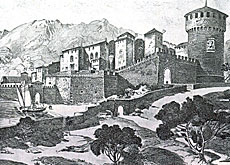Locarno gets its own da Vinci mystery

The great Italian artist, Leonardo da Vinci, may have helped design the Visconti Castle in the southern Swiss town of Locarno, say experts.
Research by Italian historian Marino Viganò has convinced Carlo Pedretti, director of the Los Angeles-based Armand Hammer Center for Leonardo Studies, that da Vinci created the castle’s bastion.
“There is a 95 per cent probability that the ravelin [a defensive outwork, or bastion] of Locarno is a brainchild of Leonardo,” Pedretti told a news conference in Locarno, in the Italian-speaking canton of Ticino, earlier this month.
Pedretti is convinced that a document exists proving the Renaissance genius, who was also a scientist, inventor and architect, was involved.
“I’m absolutely sure that we will find a slip of paper, small though it may be, which will be written evidence of the presence of Leonardo in Locarno. This in turn will allow us to prove that he designed the Visconti Castle.”
His comments came more than four years after Viganò began his painstaking investigations and analysis of the remains of the bastion which was built in the early 16th century.
Pedretti said it had only recently been proven that da Vinci had visited the court of the French king, Louis XII, in 1507 – the year the Visconti castle, which was then part of the French empire, was built.
“We are facing the prospect of an exceptional archaeological find. The question is: when will we be able to present the evidence to the world?”
Unesco heritage site?
Pedretti is convinced that the fortifications stand a good chance of being recognised by Unesco, the United Nations science and culture organisation, as a world culture heritage site.
“It’s one of the rare architectural projects of Leonardo that was realised and has survived,” he added.
Locarno was of strategic importance to the dukedom of Milan – which belonged to the French – having repeatedly come under attack by troops from central Switzerland.
Experts say it is likely that da Vinci was given the task of helping to improve the outpost’s security.
“Locarno was probably the most vulnerable stronghold and the rulers wanted to beef up its defences,” said Viganò.
It is believed that, at that time, the artist was the only person with the expertise at the court in Milan to carry out the task.
The purpose of a bastion was to stop enemy troops from advancing further south after they had captured the nearby town of Bellinzona in around the year 1500.
Accessible to public
The latest support for the da Vinci theory was welcomed by the mayor of Locarno, Carla Speziali.
“The first step for us will be to put the bastion back into public hands since it has been in private ownership until now. Our next task will be to bring to life this fascinating historical monument,” she said.
Mario Botta, the star Swiss architect with roots in Ticino, congratulated the Locarno mayor on her initiative.
“I’m happy to see that the local authorities have pledged to play an active part and honour the monument,” said Botta.
He added this was by no means a given in a region which had a reputation of being a bit slow to recognise great opportunities.
swissinfo, Françoise Gehring in Locarno
Leonardo da Vinci’s notebooks, dated by scholars to between 1487 and 1490, contain studies for five-sided bastions.
The French adopted his designs for Milan’s Sforzesco Castle in 1499, seven years before the Locarno bastion was built.
Plans to fortify Locarno had already been approved in 1500.
Da Vinci was called to Milan in 1506 and he was awarded a special title by King Louis XII in 1507.
The Armand Hammer Center for Leonardo Studies is part of the Art History Faculty of the University of California at Los Angeles (UCLA).
Carlo Pedretti specialises in Leonardo da Vinci and is considered one of the foremost experts on the Renaissance artist.
Marino Viganò lectures on military architecture at the Catholic University in Milan, Italy.
The Visconti Castle in Locarno was the seat of the Visconti Dukes of Milan, who represented the French king.

In compliance with the JTI standards
More: SWI swissinfo.ch certified by the Journalism Trust Initiative

You can find an overview of ongoing debates with our journalists here. Please join us!
If you want to start a conversation about a topic raised in this article or want to report factual errors, email us at english@swissinfo.ch.